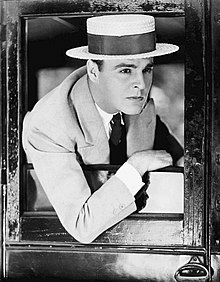| Nick Carraway | |
|---|---|
| The Great Gatsby character | |
 Nick Carraway as portrayed by actor Neil Hamilton in The Great Gatsby (1926) | |
| First appearance | The Great Gatsby (1925) |
| Created by | F. Scott Fitzgerald |
| Portrayed by | See list |
| In-universe information | |
| Gender | Male |
| Occupation | Bond salesman |
| Relatives | Daisy Buchanan (cousin) |
| Origin | American Midwest |
| Nationality | American |
Nick Carraway is a fictional character and narrator in F. Scott Fitzgerald's 1925 novel The Great Gatsby. The character is a Yale University alumnus from the American Midwest, a World War I veteran, and a newly arrived resident of West Egg on Long Island, near New York City. He is a bond salesman and the neighbor of enigmatic millionaire Jay Gatsby. He facilitates a sexual affair between Gatsby and Nick's second cousin, once removed, Daisy Buchanan which becomes one of the novel's central conflicts. Carraway is easy-going and optimistic, although this latter quality fades as the novel progresses. After witnessing the callous indifference and insouciant hedonism of the idle rich during the riotous Jazz Age, he ultimately chooses to leave the eastern United States forever and returns to the Midwest.[1]
The character of Nick Carraway has been analyzed by scholars for nearly a century and has given rise to a number of critical interpretations. According to scholarly consensus, Carraway embodies the pastoral idealism of Fitzgerald.[2] Fitzgerald identifies the Midwest—those "towns beyond the Ohio"—with the perceived virtuousness and rustic simplicity of the American West and as culturally distinct from the decadent values of the eastern United States.[2] Carraway's decision to leave the East evinces a tension between a complex pastoral ideal of a bygone America and the societal transformations caused by industrialization.[3] In this context, Nick's repudiation of the East represents a futile attempt to withdraw into nature.[4] Yet, as Fitzgerald's work shows, any technological demarcation between the eastern and western United States has vanished,[5] and one cannot escape into a pastoral past.[4]
Since the 1970s, scholarship has often focused on Carraway's sexuality.[6][7] In one instance in the novel, Carraway departs an orgy with a feminine man and—following suggestive ellipses—next finds himself standing beside a bed while the man sits between the sheets clad only in his underwear.[8] Such passages have led scholars to describe Nick as possessing a queerness and prompted analyses about his attachment to Gatsby.[9] For these reasons, the novel has been described as an exploration of sexual identity during a historical era typified by the societal transition towards modernity.[10][11]
The character has appeared in various media related to the novel, including stage plays, radio shows, television episodes, and feature films. Actor Ned Wever originated the role of Nick on the stage when he starred in the 1926 Broadway adaptation of Fitzgerald's novel at the Ambassador Theatre in New York City.[12] That same year, screen actor Neil Hamilton played the role in the now lost 1926 silent film adaptation.[13] In subsequent decades, the role has been played by many actors including Macdonald Carey, Lee Bowman, Rod Taylor, Sam Waterston, Paul Rudd, Bryan Dick, Tobey Maguire and others.
- ^ Mizener 1965, p. 190.
- ^ a b Mizener 1965, p. 190; Marx 1964, p. 363.
- ^ Marx 1964, pp. 358–64.
- ^ a b Cite error: The named reference
Leo Marxwas invoked but never defined (see the help page). - ^ Turnbull 1962, p. 46.
- ^ Cite error: The named reference
Kerr Sexualitywas invoked but never defined (see the help page). - ^ Fraser 1979, pp. 331–332; Thornton 1979, pp. 464–466.
- ^ Vogel 2015, p. 34; Kerr 1996, pp. 412, 414; Bourne 2018.
- ^ Fraser 1979, pp. 331–332; Thornton 1979, pp. 464–466; Paulson 1978, p. 329; Kerr 1996, pp. 409–411; Vogel 2015, p. 34.
- ^ Cite error: The named reference
Identity Explorationwas invoked but never defined (see the help page). - ^ Cite error: The named reference
Identity Venturingwas invoked but never defined (see the help page). - ^ Playbill 1926.
- ^ Green 1926.